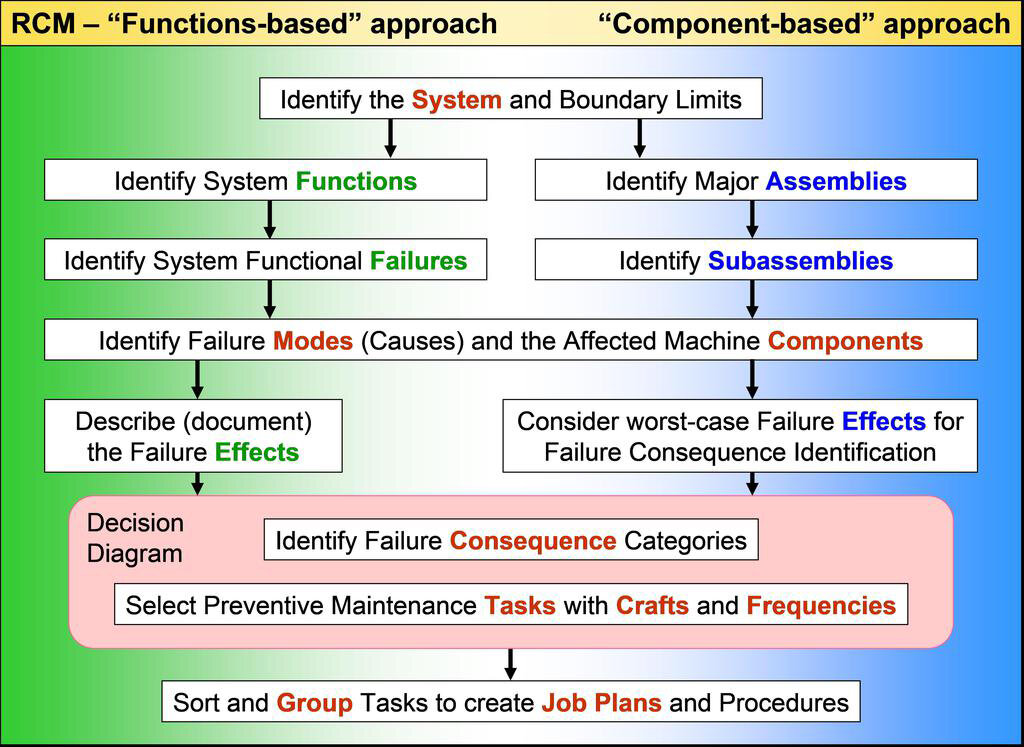RCM - The Bigger Picture
Although the arguments in favour of Classical RCM (Reliability Centred Maintenance) remain valid, Dave Porrill, Principal Consultant, considers whether it is enough to settle for RCM alone. Here are his thoughts:
Maintenance Strategy Development
As I survey the ubiquitous volumes of maintenance books and journals available today, I am amazed by the large number of supposedly different analytical methodologies that one can choose from when selecting a suitable tool for Maintenance Strategy Development. There are several common themes running through most of the currently available techniques, which should set our minds at ease as maintenance professionals, but it is the differences between these techniques that cause much of the debate and confusion.
Reliability Centred Maintenance
Perhaps the most celebrated analytical technique is RCM which has been around since the pioneering days of Nowlan and Heap (1978) and which in later years was presented to land-based industries by Moubray as RCM2. There are a multitude of variations to this central philosophy which have been designed based on the argument that Classical RCM is too time-consuming to be practical. Some of these alternative approaches are closely aligned to the original philosophy, but regrettably, there are also some which are so vastly different that they lose all resemblance to anything remotely useful for developing equipment maintenance routines!
In an attempt to terminate further debate, the Engineering Society for Advanced Mobility, Land, Sea Air and Space, International published a document titled ‘Evaluation Criteria for Reliability-Centred Maintenance (RCM) Processes’ (JA1011). This document describes the criteria that must be met in order to refer to a maintenance analysis as RCM. It is important to note, however, that just because a particular form of maintenance analysis does not meet the criteria spelled out in JA1011, it does not mean that it is not a valid analytical methodology; it simply means that the term RCM should not be applied to it.
RCM - Does It Fit?
If we consider that RCM evolved out of the airline industry, and RCM2 was largely an attempt to adapt the philosophy to land-based industries, it is not surprising that there will be circumstances where the details of RCM may feel like an uncomfortable fit in the context of a production site. For example, the criteria that are important in a nuclear power station may be noticeably different from a fruit juice factory. It must be acknowledged that the nuances and idiosyncrasies of different industrial organisations would benefit from allowing a certain amount of flexibility in the way they develop their preventive maintenance routines.
Classical RCM
Although the arguments in favour of Classical RCM are valid, they are not sufficient to categorically discount the applicability of alternative techniques. There will be times in most industries when it will be appropriate to conduct a full RCM analysis on a critical equipment system; there will also be many occasions where the rigour and effort is not justified, and so a more simplified approach will suffice. I should like to propose that a combination of approaches, applied in balanced harmony at the right time and for the right reasons, will deliver the optimum overall results.
One alternative technique that I have used to good effect alongside Classical RCM is a ‘component-based approach. While RCM requires the rigorous documentation of the Functions, Functional Failures and Failure Effects, the component-based approach does not. It considers the hierarchical structure of the equipment system broken down to component level, where a component is the lowest practical level at which it is possible to implement a suitable failure management policy. The key to the credibility of this approach is the rigour of the decision diagram, which is very closely aligned to the original proposed by Nowlan and Heap. The graphic below illustrates how it is feasible for the two methodologies to be used alongside each other in the same industrial setting.
Choose the Right Tool for the Right Occasion
So, for those less critical equipment systems, where the benefit of conducting a full RCM analysis may be challenged, taking the component-based approach will still provide all the rigour you need for a thorough, defendable maintenance strategy, but could save about a quarter of the total analysis and implementation time (as demonstrated during a recent RCM study). Given that most analyses will involve a team of people, this time saving translates into a significant cost benefit, as well as buying back some credibility in the eyes of management by demonstrating your flexibility to choose the right tool for the right occasion.
I call it ‘disciplined flexibility, with a dose of common sense!
MCP Consulting Group offers a variety of maintenance management courses. To support business best practice we provide a range of City & Guilds courses in our Technical Skills and Asset Management and Reliability training programmes. All courses are designed to bring about improved manufacturing capability and performance.



Prices Quoted Exclude VAT
Course Type | Maintenance and Asset Management
Certificate | City & Guilds Accreditation Certificate
Duration of Course | 3 Days
Location | Solihull Training Centre